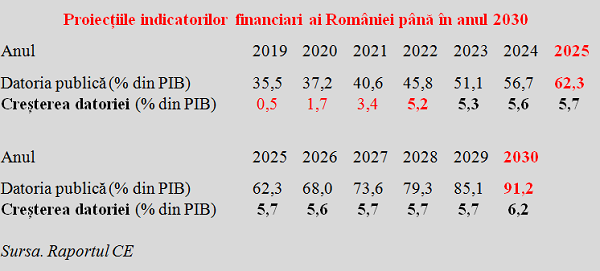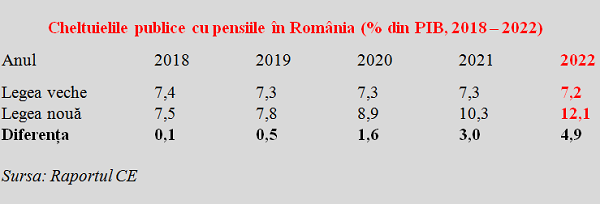With current data and based on the legislation already adopted, Romania’s public debt is forecasted to reach 91.2% of GDP, according to the analysis of sustainability and financial risks recently presented by the European Commission within the European Semester.
This document confirms the conclusions presented in a limited version even since mid-February.
Simply put, the idea is that the current approach of forcing the increase in social benefits without having the appropriate revenues behind will cause a major long-term imbalance.
The European Commission warns us that, unless we take action NOW, as of 2022 until 2030, an additional public debt of over FIVE PERCENTAGES OF GDP would be accumulated EACH YEAR.
*
- Romania’s financial indicators forecast until 2030
- Year
- Public debt (% of GDP)
- Debt increase (% of GDP)
*
In the document that the EC put forward, chapter four, called „Reform priorities”, 4.1 „Public finances and taxation”, 4.1.1. „Fiscal policy”, graph 4.1.2, page, 25, we find the following values.
Which, correlated with the above data, do not require any great expertise to conclude from where the accumulation of public debt will occur in this decade.
*
- Public pension expenditure in Romania (% of GDP)
- Year
- Former law
- Actual law
*
Change
Therefore, we have no money (we can get it if we borrow) to enforce the pension increase law. Although, it should be said, even the slow but noticeable reduction in the percentage allocated to pensions under the former law is not alright. Either we find the way to properly increase tax revenues, or we keep ourselves within the real possibilities of the public budget, from which we should also build highways, hospitals or schools.
Of course, (unrealistic) promises have been made even since four years ago. The public, pressed by daily necessities, is now looking forward to the deadline set for September.
We are now close to the elections and the autumn is when chickens are counted (unfortunately almost simultaneously) for politics and the economy.
The idea would be to find a feasible compromise under the given conditions. Without keeping head towards the wall, but also without instantly braking, so that we save our face from the gloomy scenario presented by the European Commission. That is to say, finally, to move from a separation between the political offer and the economic realities to a real economic policy, with social Europe nuances.












